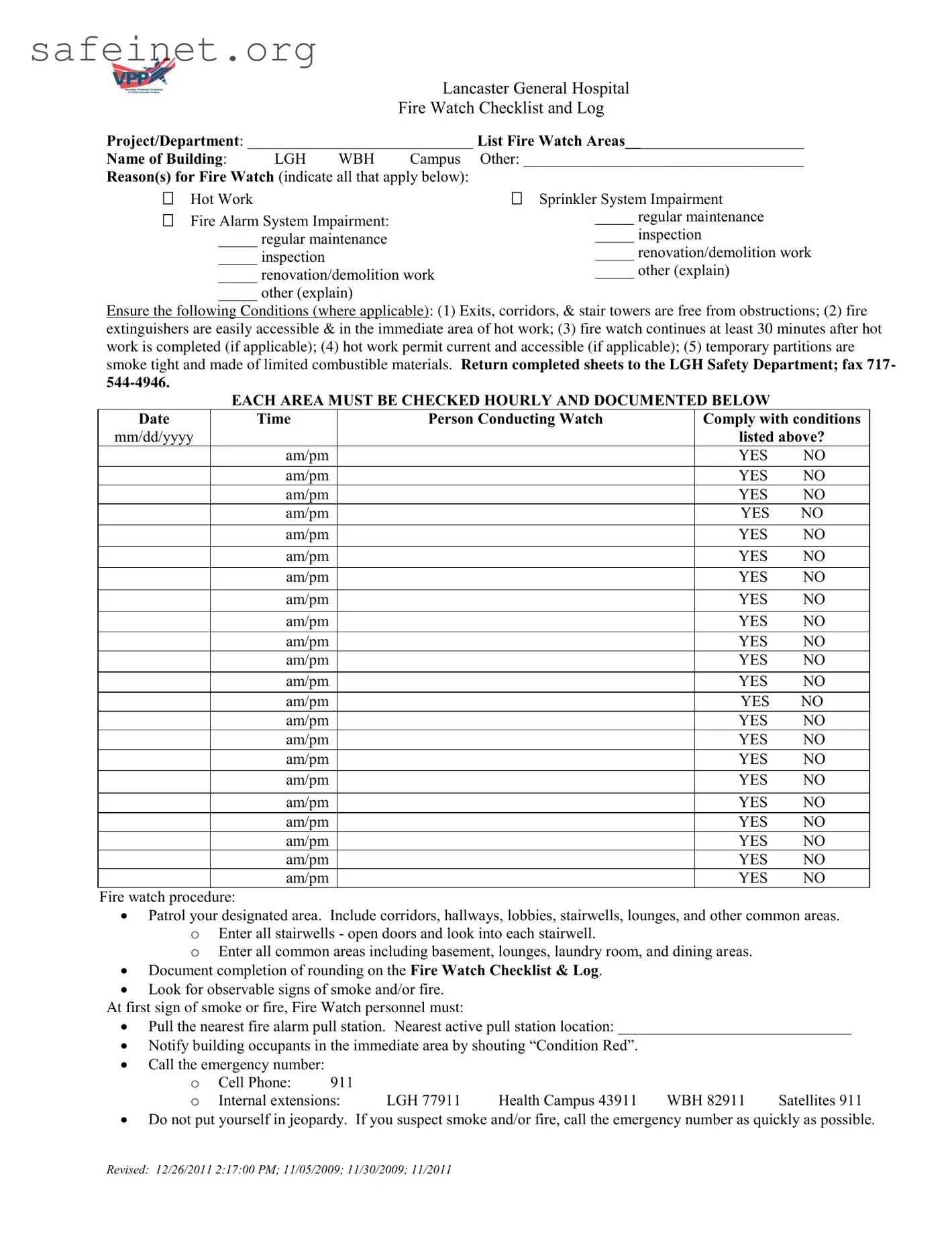Lancaster General Hospital
Fire Watch Checklist and Log
Project/Department: _____________________________ List Fire Watch Areas_______________________
Name of Building: |
LGH |
WBH |
Campus |
Other: ____________________________________ |
Reason(s) for Fire Watch (indicate all that apply below): |
|
Hot Work |
|
|
|
Sprinkler System Impairment |
Fire Alarm System Impairment: |
|
_____ regular maintenance |
_____ regular maintenance |
|
_____ inspection |
|
|
|
_____ inspection |
_____ renovation/demolition work |
|
_____ other (explain) |
|
_____ renovation/demolition work |
|
|
|
_____ other (explain) |
|
Ensure the following Conditions (where applicable): (1) Exits, corridors, & stair towers are free from obstructions; (2) fire extinguishers are easily accessible & in the immediate area of hot work; (3) fire watch continues at least 30 minutes after hot work is completed (if applicable); (4) hot work permit current and accessible (if applicable); (5) temporary partitions are smoke tight and made of limited combustible materials. Return completed sheets to the LGH Safety Department; fax 717- 544-4946.
EACH AREA MUST BE CHECKED HOURLY AND DOCUMENTED BELOW
Date |
Time |
Person Conducting Watch |
Comply with conditions |
mm/dd/yyyy |
|
|
listed above? |
|
am/pm |
|
YES |
NO |
|
|
|
|
|
|
am/pm |
|
YES |
NO |
|
am/pm |
|
YES |
NO |
|
am/pm |
|
YES |
NO |
|
|
|
|
|
|
am/pm |
|
YES |
NO |
|
|
|
|
|
|
am/pm |
|
YES |
NO |
|
|
|
|
|
|
am/pm |
|
YES |
NO |
|
|
|
|
|
|
am/pm |
|
YES |
NO |
|
|
|
|
|
|
am/pm |
|
YES |
NO |
|
|
|
|
|
|
am/pm |
|
YES |
NO |
|
am/pm |
|
YES |
NO |
|
|
|
|
|
|
am/pm |
|
YES |
NO |
|
am/pm |
|
YES |
NO |
|
am/pm |
|
YES |
NO |
|
am/pm |
|
YES |
NO |
|
|
|
|
|
|
am/pm |
|
YES |
NO |
|
|
|
|
|
|
am/pm |
|
YES |
NO |
|
|
|
|
|
|
am/pm |
|
YES |
NO |
|
am/pm |
|
YES |
NO |
|
am/pm |
|
YES |
NO |
|
am/pm |
|
YES |
NO |
|
am/pm |
|
YES |
NO |
Fire watch procedure:
Patrol your designated area. Include corridors, hallways, lobbies, stairwells, lounges, and other common areas. O Enter all stairwells - open doors and look into each stairwell.
O Enter all common areas including basement, lounges, laundry room, and dining areas.
Document completion of rounding on the Fire Watch Checklist & Log.
Look for observable signs of smoke and/or fire.
At first sign of smoke or fire, Fire Watch personnel must:
Pull the nearest fire alarm pull station. Nearest active pull station location: ______________________________
Notify building occupants in the immediate area by shouting “Condition Red”.
Call the emergency number:
O |
Cell Phone: |
911 |
|
|
|
|
O |
Internal extensions: |
LGH 77911 |
Health Campus 43911 |
WBH 82911 |
Satellites 911 |
Do not put yourself in jeopardy. If you suspect smoke and/or fire, call the emergency number as quickly as possible.
REVISED: 12/26/2011 2:17:00 PM; 11/05/2009; 11/30/2009; 11/2011

